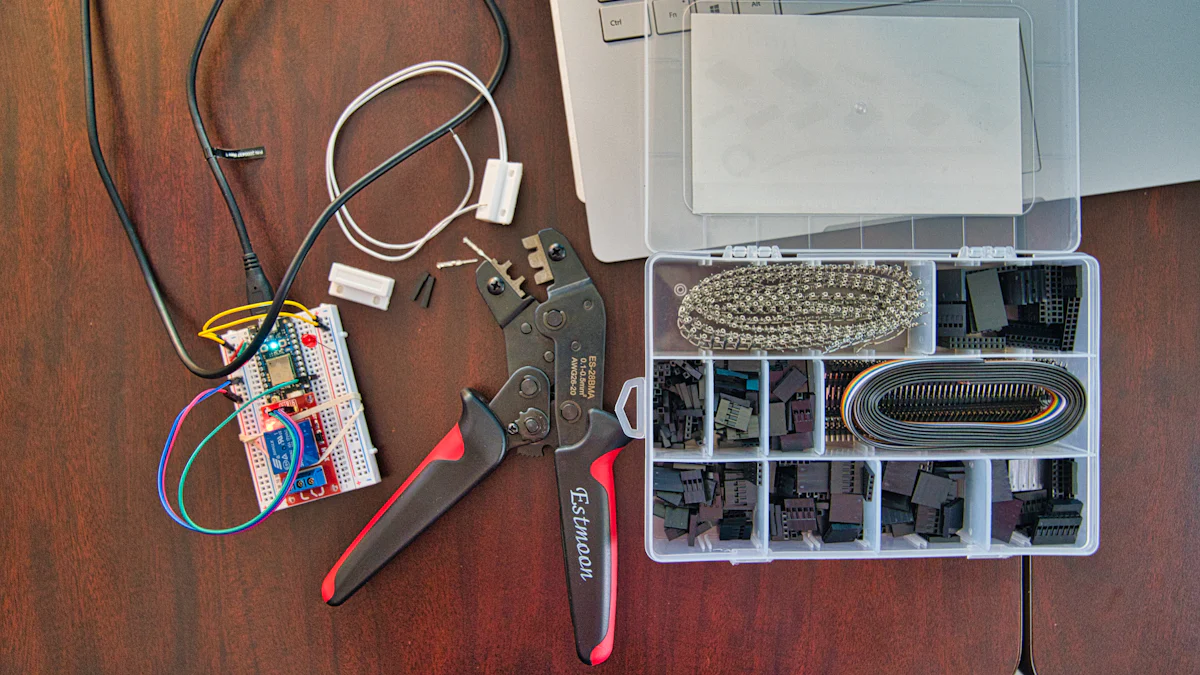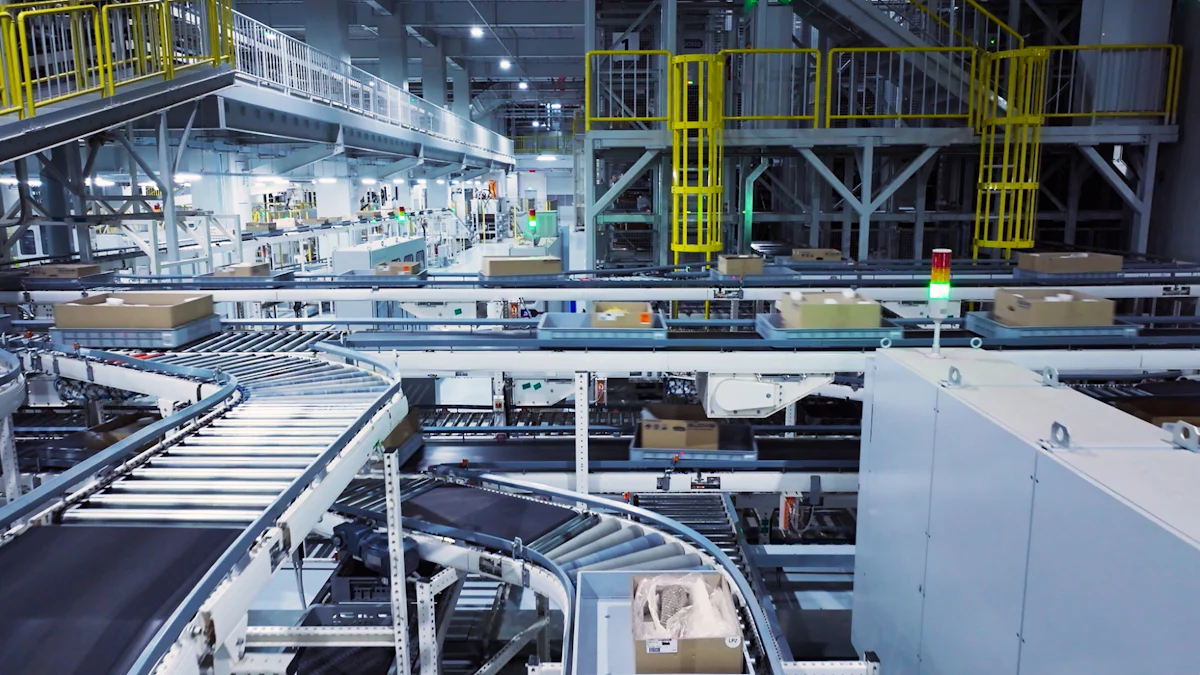

A Connected Factory revolutionizes manufacturing by integrating digital technology. This factory model enhances productivity and operational efficiency. Manufacturers can expect to triple productivity growth between 2020 and 2030. Real-time data from IoT sensors and advanced analytics drive innovation. Existing IT infrastructure combines with new technologies like private 5G and artificial intelligence. This integration reduces costs and improves performance. Connectivity transforms modern manufacturing, making processes smarter and more efficient.
Understanding Connected Factory
Definition and Key Concepts of Connected Factory
A Connected Factory represents a modern manufacturing environment. This environment uses digital technology for seamless communication. The Internet of Things (IoT) plays a crucial role in this setting. IoT devices gather data from various sources. This data provides real-time insights. These insights help improve decision-making and productivity.
Internet of Things (IoT) in Manufacturing
IoT transforms traditional manufacturing processes. Sensors collect data from machines and equipment. This data helps identify inefficiencies. Manufacturers can address these inefficiencies promptly. IoT adoption reshapes industries. It creates new economic opportunities. The global market sees a rise in smart manufacturing systems. IoT technologies drive this growth.
Role of Data and Analytics
Data and analytics form the backbone of a Connected Factory. Big data analytics processes vast amounts of information. This processing leads to informed decisions. Manufacturers optimize processes with these insights. Productivity improves significantly. Real-time data analysis enhances operational efficiency. Decision-makers gain a deeper understanding of operations.
Components of a Connected Factory
A Connected Factory consists of several key components. Each component plays a vital role in the manufacturing process.
Smart Machinery and Equipment
Smart machinery integrates advanced technology. This technology includes sensors and automation. Machines communicate with each other. This communication ensures smooth operations. Smart equipment monitors its performance. Predictive maintenance becomes possible. Downtime reduces, leading to increased productivity.
Integrated Systems and Software
Integrated systems connect various factory elements. These systems include software solutions. Software manages data flow between devices. Integration ensures seamless operations. Manufacturers benefit from streamlined processes. Efficiency improves across the production line. Connectivity enhances overall performance.
Benefits of Connected Factory

Enhanced Efficiency and Productivity of Connected Factory
Real-time Monitoring and Control
Connected Factory technology provides real-time monitoring capabilities. Sensors collect data from machinery and equipment. This data gives you immediate insights into operations. You can identify issues as they occur. Quick responses prevent downtime. Real-time control enhances the efficiency of production lines. Manufacturers report an 18% increase in worker productivity. Safety accidents reduce by 60%. Non-conformity issues drop by 64%.
Predictive Maintenance
Predictive maintenance becomes possible with a Connected Factory. Sensors monitor equipment health continuously. Data analysis predicts potential failures. You can schedule maintenance before breakdowns occur. This approach minimizes unexpected downtime. Predictive maintenance extends the lifespan of machinery. Operational efficiency improves significantly.
Cost Reduction and Resource Optimization of Connected Factory
Energy Management
Connected Factories optimize energy usage. Sensors track energy consumption in real time. Data analytics identify areas of waste. You can implement energy-saving measures promptly. Efficient energy management reduces operational costs. Manufacturers see significant savings on utility bills.
Waste Minimization
Waste minimization is another benefit of a Connected Factory. Real-time data helps you track material usage. You can identify excesses and inefficiencies. Adjustments reduce waste generation. Streamlined processes lead to better resource utilization. Manufacturers achieve higher yields with less input. Cost savings contribute to increased profitability.
Challenges in Implementing Connected Factory
Implementing a Connected Factory involves several challenges. These challenges can affect the transition to a more digital manufacturing environment.
Technical Challenges of Connected Factory
Integration with Legacy Systems
Legacy systems often pose significant hurdles. Many factories rely on outdated technology. These systems do not easily integrate with modern digital solutions. You need to ensure compatibility between old and new technologies. This process requires time and resources. Careful planning helps address these integration issues. Successful integration enhances the overall efficiency of a Connected Factory.
Cybersecurity Concerns
Cybersecurity remains a critical concern for Connected Factories. Digital connectivity increases vulnerability to cyber threats. Hackers target sensitive data and operational systems. Protecting your factory requires robust security measures. Regular updates and monitoring help safeguard against breaches. Training employees on cybersecurity best practices is essential. A secure Connected Factory maintains trust and operational integrity.
Organizational Challenges of Connected Factory
Workforce Training and Adaptation
A Connected Factory demands a skilled workforce. Employees must understand new technologies and processes. Training programs are vital for skill development. Workers need to adapt to digital tools and systems. Resistance to change can slow down progress. Encouraging a culture of learning supports adaptation. Well-trained employees contribute to the success of a Connected Factory.
Change Management
Change management plays a crucial role in implementing a Connected Factory. Transitioning to a digital environment requires strategic planning. Clear communication helps manage expectations. Involving stakeholders in the process fosters collaboration. Addressing concerns and feedback ensures smoother transitions. Effective change management minimizes disruptions. A well-managed change process leads to successful Connected Factory implementation.
Real-world Applications of Connected Factory

Case Studies in Various Industries
Automotive Industry
The automotive industry embraces the Connected Factory model. Factories use IoT devices to track production lines. Sensors monitor machinery and equipment. This technology helps identify issues quickly. Manufacturers improve efficiency and reduce downtime. The Connected Factory enhances quality control. Real-time data ensures consistent product standards. Automotive companies see increased output and reduced defects.
Electronics Manufacturing
Electronics manufacturing benefits from Connected Factory systems. Factories integrate smart machinery and software. These tools streamline production processes. Real-time monitoring detects inefficiencies. Manufacturers adjust operations for optimal performance. The Connected Factory model supports rapid prototyping. Companies bring new products to market faster. This approach boosts competitiveness in the electronics sector.
Success Stories and Lessons Learned
Increased Output and Quality
Connected Factory implementations lead to significant gains. Companies report increased output and improved quality. Real-time data analysis identifies production bottlenecks. Manufacturers address these issues promptly. This proactive approach enhances productivity. Quality control systems ensure product consistency. The Connected Factory model delivers superior results.
Improved Supply Chain Management
Supply chain management improves with Connected Factory technologies. Factories use integrated systems for seamless communication. Data flows between suppliers and manufacturers. This transparency enhances collaboration. Companies optimize inventory levels and reduce waste. The Connected Factory supports just-in-time production. Efficient supply chains lead to cost savings and increased profitability.
Future Implications of Connected Factory
Trends and Innovations
Artificial Intelligence and Machine Learning
Artificial Intelligence (AI) and Machine Learning (ML) revolutionize the Connected Factory. AI analyzes data from factory floors. This analysis allows for intelligent decision-making in real time. Manufacturers automate complex tasks with AI. Predicting operational failures becomes possible. Energy use optimization occurs through AI-driven insights. AI transforms traditional manufacturing processes. The Connected Factory benefits from these advancements.
Advanced Robotics and Automation
Advanced robotics play a crucial role in the Connected Factory. Robots handle repetitive tasks efficiently. Automation increases production speed. Precision improves with robotic systems. Connected robots communicate with each other. This communication ensures smooth operations. Manufacturers achieve higher output levels. Robotics enhance safety by reducing human involvement in hazardous tasks. The Connected Factory leverages robotics for better performance.
Impact on Global Manufacturing Landscape
Competitive Advantage
The Connected Factory provides a competitive edge. Manufacturers streamline operations with digital technology. Real-time data enhances decision-making. Efficiency improves across production lines. Companies reduce costs and increase profitability. The Connected Factory model supports rapid innovation. Businesses adapt quickly to market changes. A strong competitive position emerges in the global landscape.
<video class="video" controls width="500px">
<source src="https://media.finebi.com/strapi/1_smart_factory_0da97c86e0.mp4" type="video/mp4" />
</video>
Sustainability and Environmental Impact
Sustainability gains importance in the Connected Factory. Energy-efficient practices reduce environmental impact. Sensors monitor resource usage in real time. Waste minimization becomes achievable. Manufacturers implement eco-friendly solutions. The Connected Factory supports sustainable development goals. Companies contribute to a greener future. Environmental responsibility aligns with business objectives.
Connected factories transform manufacturing by boosting operational efficiency. Real-time data from IoT sensors and advanced analytics drive smarter operations. Digital technology enables seamless information sharing. This connectivity improves productivity and yields. The future of manufacturing relies on these connected technologies. Industries must embrace this model to stay competitive. Adopting connected factory models ensures sustainable growth. Embrace this change for a more efficient and innovative manufacturing landscape.
FAQ
A Connected Factory uses digital technology for seamless communication. Devices, information, and elements in production connect. This includes people, machines, materials, kits, and sensors.
IoT devices gather data from various sources. This data provides real-time insights. Manufacturers use these insights to improve decision-making and productivity.
Data and analytics form the backbone of a Connected Factory. Big data analytics processes vast amounts of information. This processing leads to informed decisions. Manufacturers optimize processes with these insights.
A Connected Factory enhances efficiency and productivity. Real-time monitoring and predictive maintenance become possible. Cost reduction and resource optimization occur. Energy management and waste minimization improve.
Technical challenges include integration with legacy systems and cybersecurity concerns. Organizational challenges involve workforce training and change management.
Connected factory workers use digital tools and data management techniques. Workers integrate interactions with physical and virtual surroundings. This capability helps make faster and better decisions. Processes that workers participate in get optimized.
The automotive and electronics manufacturing industries benefit. Factories use IoT devices to track production lines. Smart machinery and software streamline processes.
Artificial Intelligence and Machine Learning revolutionize operations. Advanced robotics and automation increase production speed. Sustainability and environmental impact gain importance.
Manufacturers streamline operations with digital technology. Real-time data enhances decision-making. Efficiency improves across production lines. Companies reduce costs and increase profitability.
Continue Reading About Connected Factory
10 Must-Have Marketing Agency Reporting Tools for Your Success
Optimize your agency's performance with top reporting tools. Explore analytics, social media, SEO, and more for data-driven decisions and efficiency.
Lewis
Oct 09, 2024
Best Data Integration Platforms to Use in 2025
Explore the best data integration platforms for 2025, including cloud-based, on-premises, and hybrid solutions. Learn about key features, benefits, and top players.
Howard
Jun 20, 2024
Data Validation Techniques: Secrets to Achieving Precision and Accuracy
Master data validation techniques from manual to machine learning methods. Ensure data quality with our practical steps.
Howard
Aug 06, 2024
Best Data Integration Vendors for Seamless Workflows
Discover the top 20 data integration vendors of 2025 for seamless workflows. Compare tools like Talend, AWS Glue, and Fivetran to optimize your data processes.
Howard
Jan 22, 2025
Which Data Analysis Projects Work Best for Beginners?
Ready to shine in 2025? Discover easy data analysis projects to boost your portfolio, learn data cleaning, visualization, and tackle real-world challenges!
Lewis
Mar 10, 2025
Augmented Analytics: Unlock the Core Concepts & Benefits!
Discover augmented analytics—where AI and ML automate data prep and insights, revolutionizing decision-making for smarter, faster business strategies!
Lewis
Mar 04, 2025



